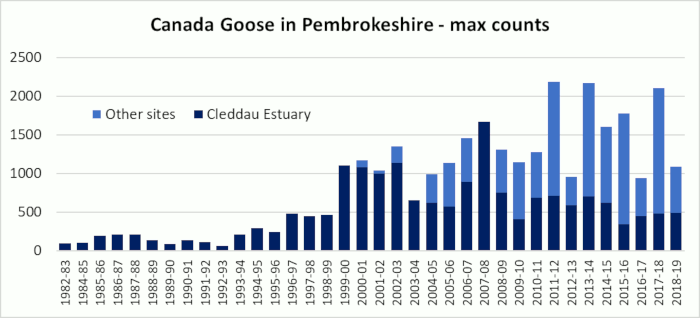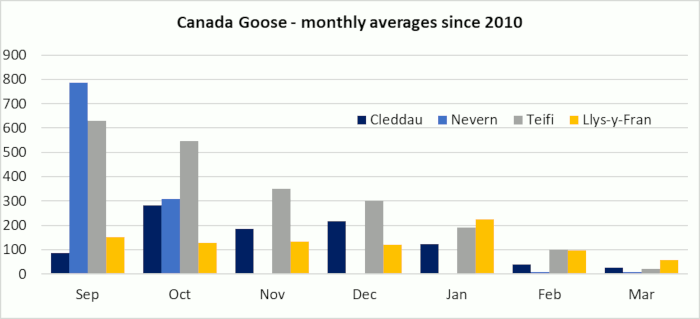Canada Goose - 2019 WeBS
 Tuesday, February 25, 2020 at 9:29AM
Tuesday, February 25, 2020 at 9:29AM
 The peak of 1669 on the Cleddau occurred in June 2007. The peak during the 'normal' count season of September to March was 651 in December that year. During the 2010s, the peak count on the Cleddau has been in June or July.
The peak of 1669 on the Cleddau occurred in June 2007. The peak during the 'normal' count season of September to March was 651 in December that year. During the 2010s, the peak count on the Cleddau has been in June or July.

Canada Geese did not appear regularly in WeBS counts on the Nevern Estuary until 2003-04. Maximum counts of between 1250 and 1500 have occurred several times in September-October since 2013-14. Counts are still low outside of this period, with none recorded in November-January, although there have been occasional counts of less than a dozen in mid-winter on non-count days.
Counts on the Teifi Estuary have numbered in the 100s since 2000, steadily increasing to 1000 in September 2010-11. Since then, there have been several counts of over 1000, all in the September-November period. It is possible that these are birds that were at the Nevern earlier in the season.
Generally small numbers (less than 50) occur on fresh-water sites. However they are more regular on LLys-y-Fran (up to 400) and on Marloes Mere (370 in 2010-11 but more usually less than 100).
Counts of Canada Geese can be surprisingly low at any site due to their habit of moving away to feed in fields, often some distance from the water, during the day.
National trend
The WeBS national trend for Canada Goose show a massive increase in the Welsh population in the late 1990s, however the overall British trend showed only a slow increase at that time. The English popluation remained relatively stable, suggesting that a part of the increasing population has moved to Wales.
Canada geese across Britain have shown a typical population curve of a “new” species, whether introduced by man or by natural expansion. Initially they remained at a relatively low level as the population established itself, followed by a rapid rise, and then (since around 2000) a levelling out as the population reaches the maximum carrying capacity of the habitat.
As the numbers of geese have increased, they have increasingly fed away from the estuary and are often missed during a count. This may account for a low peak number in some years, and it is difficult to know if this is a true indication of the population change, or just half the birds being elsewhere.
Are they causing a problem?
Some studies have been undertaken in other parts of the country regarding their effect on other wild birds using the same water bodies. This research suggests that even large numbers of Canada geese have no effect on other species of wildfowl. The increased population on the Cleddau does not, at present, appear to be having any effect on the overall numbers of wildfowl in the areas they occur. However, there may be an effect on the vegetation from trampling and eutrophication.
 Pembrokeshire Avifauna committee | Comments Off |
Pembrokeshire Avifauna committee | Comments Off |  Goose,
Goose,  WeBS,
WeBS,  wildfowl in
wildfowl in  Canada Goose
Canada Goose 
